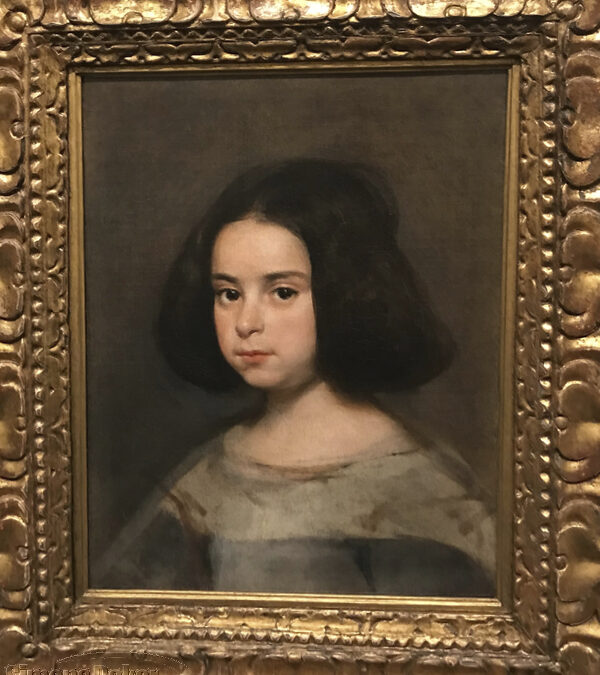
by Editor | Jan 15, 2025 | Attractions
This article was written without artificial intelligence assisted technologies.
By Elena del Valle
Photos by Gary Cox*

Christ Presented to the People, an oil on panel by Spaniard Luis de Morales, was painted circa 1565.
Splendor and Passion: Baroque Spain and Its Empire, a 57-piece Spanish Baroque exhibition at the Boca Raton Museum of Art (Boca Raton Museum of Art, 501 Plaza Real, Boca Raton, Florida 33432, https://bocamuseum.org/) in Palm Beach County, Florida, was easy to experience in a short block of time. It was an edifying and entertaining way to pass the time away from the usual tourist attractions and crowded beaches.

One of the larger artworks (oil on canvas) depicted Maria Luisa of Orléans, Queen of Spain. It was painted in 1689 by Sebastián Muñoz of Spain.
The museum interior was spacious and light-filled and at the same time intimate. Parking was plentiful and required a small effort to find. There was signage in English and Spanish next to every painting with the painter and his biography (to the best of my recollection all painters were men) as well as the title of the artwork and medium.
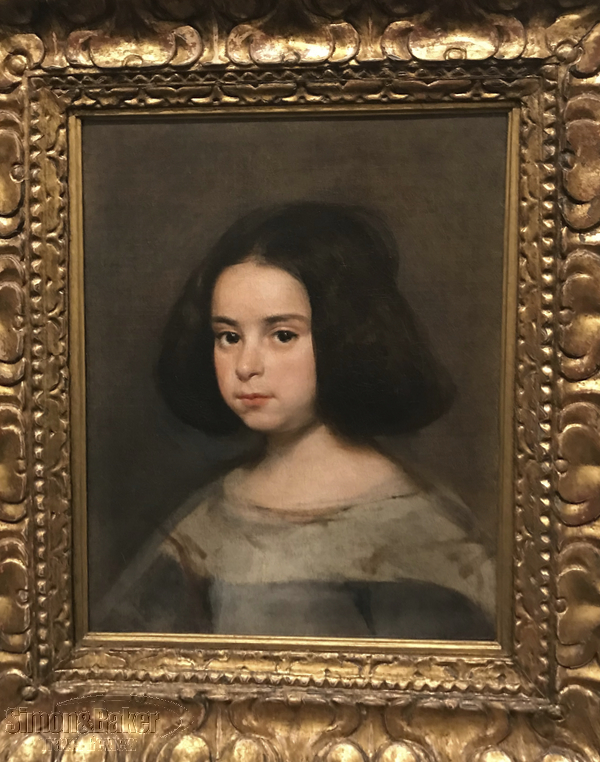
This oil on canvas titled Portrait of a Little Girl caught my eye as soon as I entered the room. It was painted by Spaniard Diego Velázquez circa 1638.
Although there was a steady stream of visitors on our weekday visit and we moved several times in order to have an unobstructed view, on the whole our experience was free of wait, crowd and line. We found complimentary parking about a block away in a shady parking garage (although it was unsettling to find out after our visit that there had recently been a fire in one of the garages). There was also metered parking close to the museum entrance.
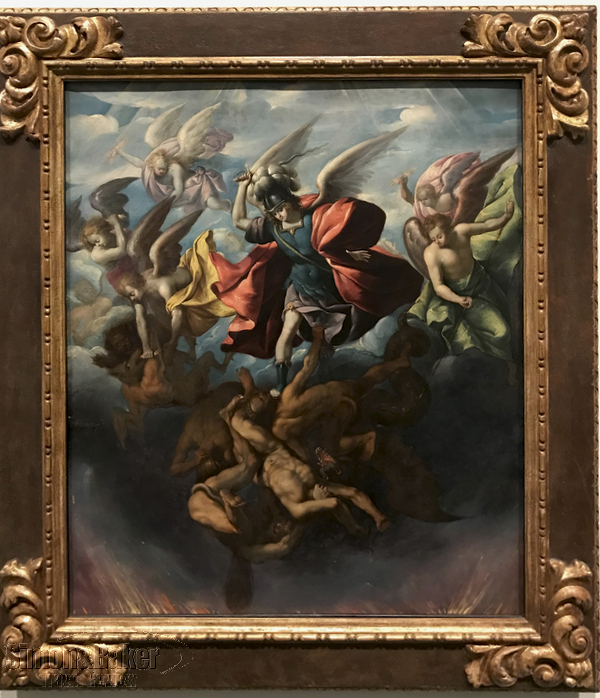
I liked the attention to detail of this Saint Michael Striking Down the Rebellious Angels, an oil on copper painting by Sebastián López de Arteaga, a Spaniard active in Mexico, circa 1650.
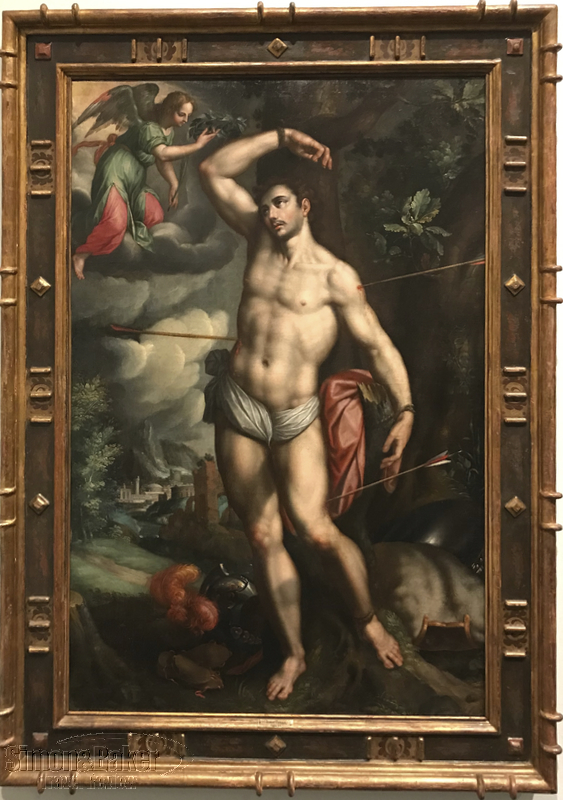
At Saint Sebastian by Alonso Vázquez, a Spanish painter, the viewer’s attention is drawn to the martyr’s body.
It was touted as the world premiere of Spain’s Golden Age exhibit, part of the Renaissance and Baroque collection of The Hispanic Society Museum & Library (Broadway between 155th and 156th Streets New York, New York 10032, https://hispanicsociety.org/), in promotional materials. According to Spainculture.us the exhibition is due to be displayed at two additional venues. Among the 16th and 17th century art were works by the El Greco (Doménikos Theotokópoulos), Bartolomé Esteban Murillo, and Diego Velázquez.
*Flash photography was forbidden.
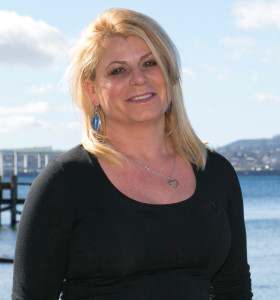
by Editor | Jan 4, 2023 | Accomodations, Attractions, Ecotourism, Food and Wine, Luxury Travel, Restaurants

*Wayne’s Waiatoto River Safari, a private river outing
Under normal circumstances our articles are based exclusively on the experiences and photography of our contributors at a destination and voyage. Due to the Covid-19 pandemic we have halted travel. For those ready to travel now we are offering limited updates about destinations, properties and tours we featured in the past and whose representatives have responded to our questions and requests for updates. This series of updates began in 2021.
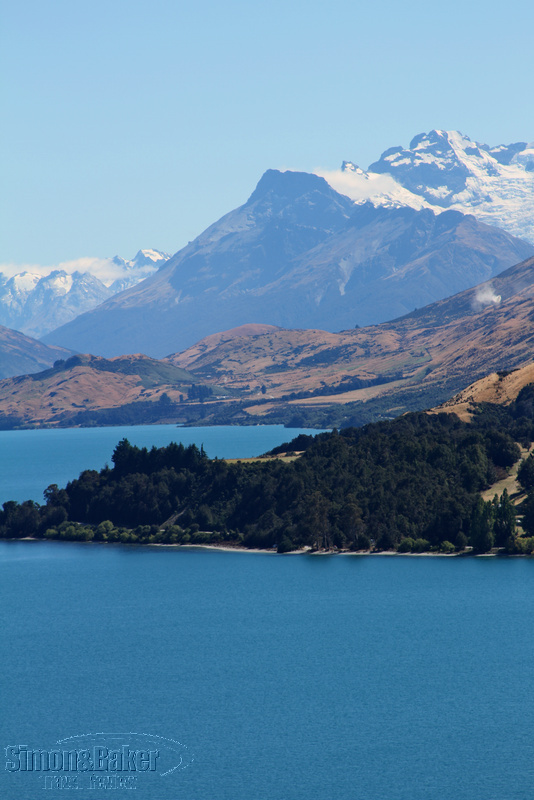
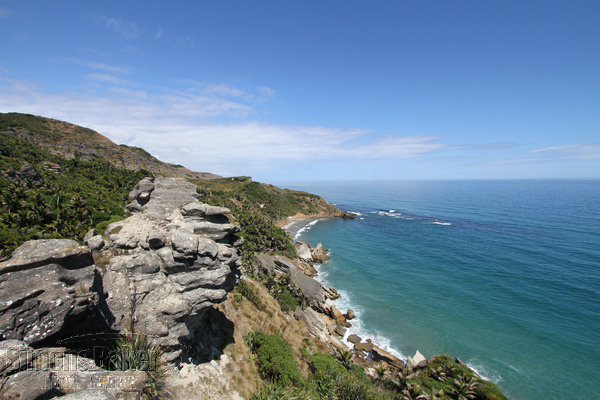
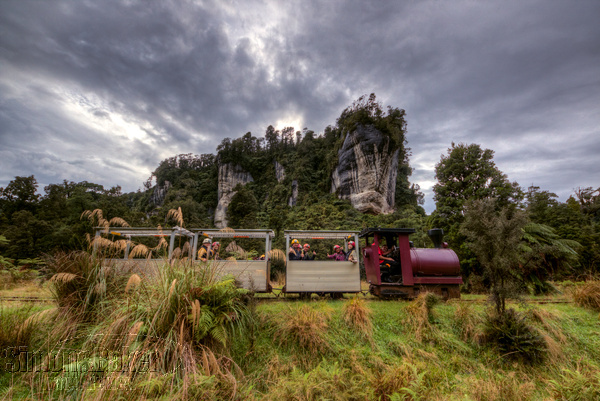
In 2019, following a trip to New Zealand and private tour, we profiled Aroha New Zealand Tours Intrepid, South Island. Three of the properties in that itinerary have failed to reply to our emails, two others have closed and one of the attractions is no longer in business. Lakestone Lodge and Cabot Lodge shared updates and responded to questions, see Update: NZ lodge near Fiordland National Park and Update: NZ lodge welcoming international guests.
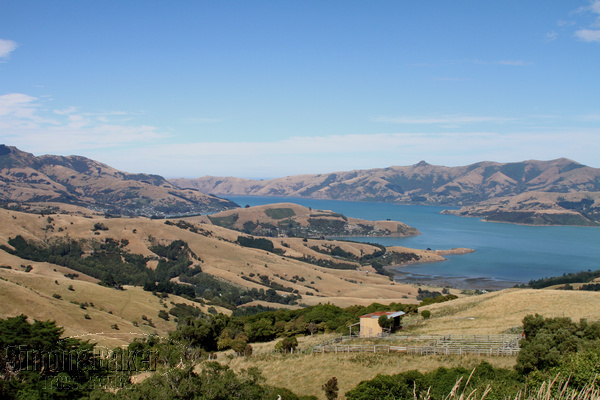
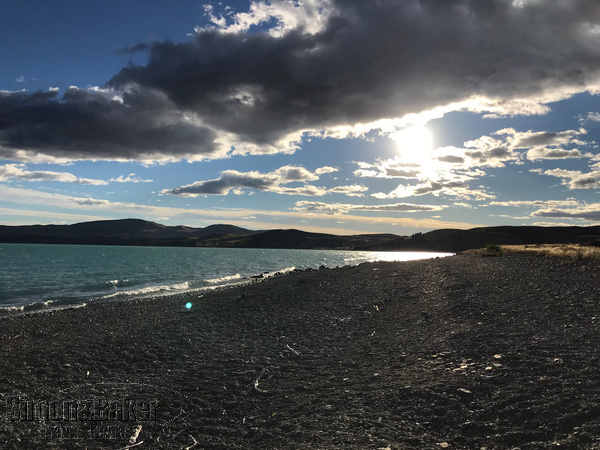
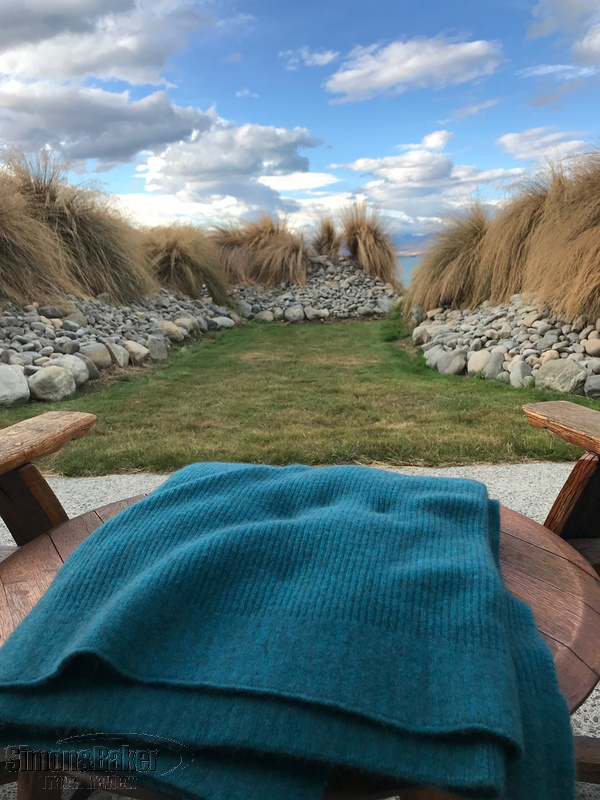
We recently contacted Veronika Vermeulen, director, Aroha New Zealand Tours Ltd. to ask about the bespoke luxury tour company and current travel conditions in New Zealand. Below are our questions and her answers.

Veronika Vermeulen, director, Aroha New Zealand Tours Ltd.
LTR: Are you welcoming international travelers?
VV: Yes we are open to all travellers. Tours started back with neighbouring countries in July, and September in general.
LTR: A number of travel business across the globe have shut down post pandemic. Some travelers have been stranded as a result. What is the situation in this regard in New Zealand and with your company?
VV: Everybody was able to leave New Zealand with the help of our company and our government in the following month after the borders were closed. However, some people decided to stay for a month (some have yet to leave) to sit out the world crisis in New Zealand.
LTR: What, if any, policies and safeguards do you have in response to Covid-19?
VV: We have applied government Covid regulation and still provide today a Covid-19 Safety Plan. We are committed to keeping you safe.
On the other hand we are not taking long pre pays and only request a small down payment, to cover our original service cost. Main payment is only required 40 days before arrival (conditions apply with some premium luxury stays).
LTR: Is there flooding, a water shortage/drought or other condition(s) affecting facilities, guests amenities, safe and comfortable travel in New Zealand?
VV: No, none of this is affecting New Zealand for now.
LTR: Are there any updates to your services and tours you care to share. Do you offer private accommodations like rental homes or small lodges for extended stays (a week or longer) and for guest that want a private or isolated stay?
VV: We decided to stay even more unique and boutique with a concentration on customer services rather than the high turnover. We can offer private stays (boutique properties) for privacy and extended stays. However, we still concentrate on private guided tours as our primary sector.
LTR: Would you share details of any extended stay packages such as weekly or monthly rates.
VV: We 100 percent customised and have no standard rates!
See example pricing attached for 2 people.
LTR: New Zealand news of youth gangs, future earthquake risks and other severe weather events have been in the news this year. Would you comment on the likelihood that a visitor might be affected by one or more of those issues?
VV: No gangs are effecting any traveller!
Earthquakes are likely but no danger. Common we are called the shaky ales!
Floods like most other countries around the world.
LTR: Are Amisfield Bistro & Cellar Door, Wayne’s Waiatoto River Safari, Tasman Helicopter, Underworld Rafting all operating normally?
VV: Yes all these are running normal again
*Photos were taken during a pre-pandemic trip, except for the photo of Veronika Vermeulen provided by Aroha New Zealand Tours Ltd.
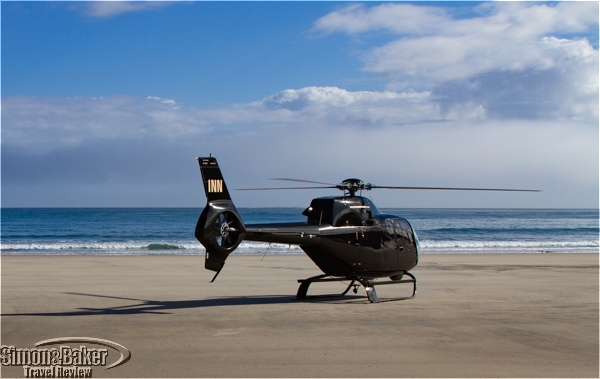
by Editor | Feb 3, 2020 | Attractions, Luxury Travel, New Articles

We were the only people at Wharariki Beach – click to expand to full size
Article and photos by Elena del Valle
My off the beaten track Intrepid tour of the South Island (Te Waipounamu) of New Zealand began in Nelson. I was originally supposed to fly from the Nelson airport to the Westhaven Retreat by helicopter following a domestic flight into Nelson. It would have been faster than the multi-hour drive. Most importantly we would soar above the popular Tasman National Park, the smallest national park in New Zealand and one of the most popular.
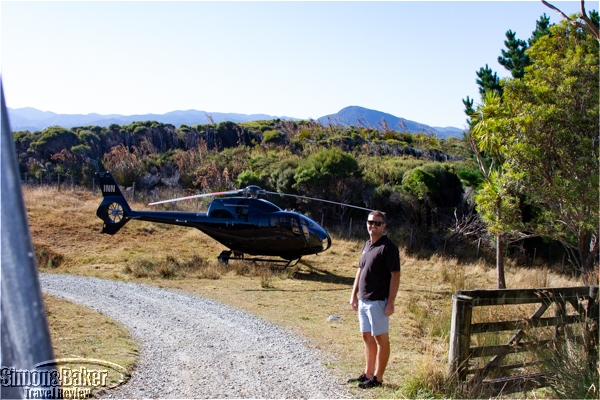
Pilot Logan Moore standing in front of the Eurocopter EC120 at Westhaven Retreat
When a series of wildfires broke out near Nelson I anticipated my helicopter flight would be cancelled and it was. While I enjoyed the drive with my guide (Veronika Vermeulen, owner, Aroha New Zealand Tours) because it allowed me to get to know her and see a bit of the country, I was disappointed at having missed the helicopter flight. Fortunately, Veronika found a work around.
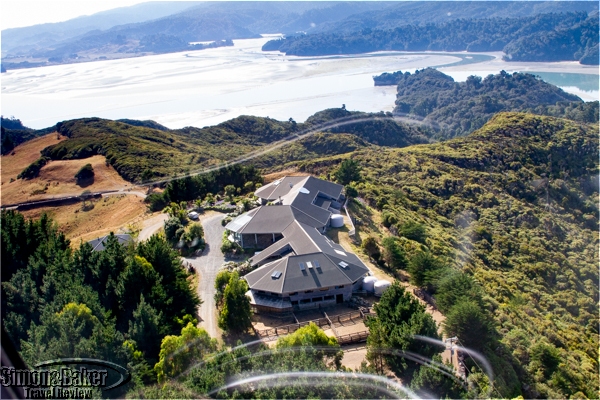
Our view of Westhaven Retreat as we departed
She scheduled the private Top of the South Tour on our departure. To make it possible on our departure day she left Westhaven Retreat early in the morning in the sports utility vehicle with our luggage. I stayed behind to enjoy a leisurely breakfast and the pretty ocean vistas. A few minutes after breakfast, from the expansive windows of the Westhaven dining room, I spotted a tiny metal bird approaching. In the blink of an eye the other guests and I watched it land on the nearby lawn.
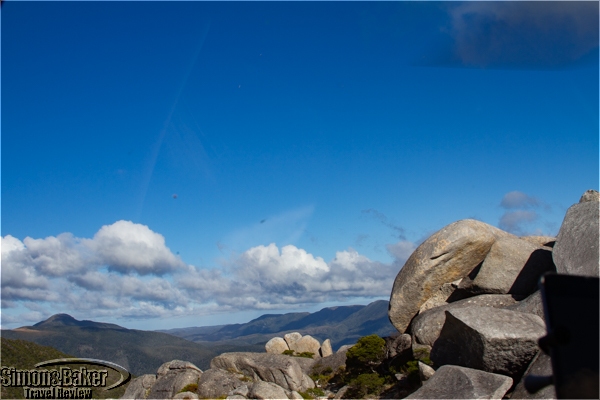
At the Mount Olympus Lord of the Rings film site
Within minutes Logan Moore, chief executive officer and pilot of Tasman Helicopters (Tangmere place, Nelson Airport www.tasmanhelicopters.co.nz, info@tasmanhelicopters.co.nz, 035288075) and I were airborne. From departure to arrival we didn’t see a soul. We flew in a Eurocopter EC120 built in 2008 with just over 2,000 flight hours and capacity for four passengers.

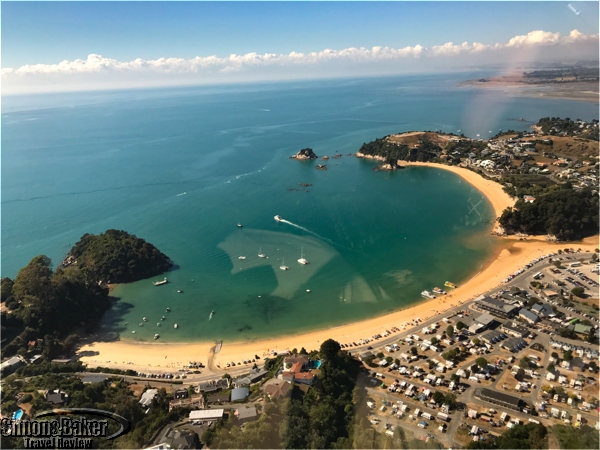
We flew over coastal areas, some isolated and some well populated
The 90-minute flight was one of the highlights of my trip to New Zealand. We stopped twice, at Wharariki Beach and at the Mount Olympus Lord of the Rings film site. I especially loved the dazzling beach stop. For a few minutes I had the impression we were the only humans for miles on the beautiful and unspoiled beach. Minutes later we landed in a rocky and hilly landscape. As soon as Logan identified which Lord of the Rings movie the film site belonged to I recognized it. The video clip on his tablet confirmed it.
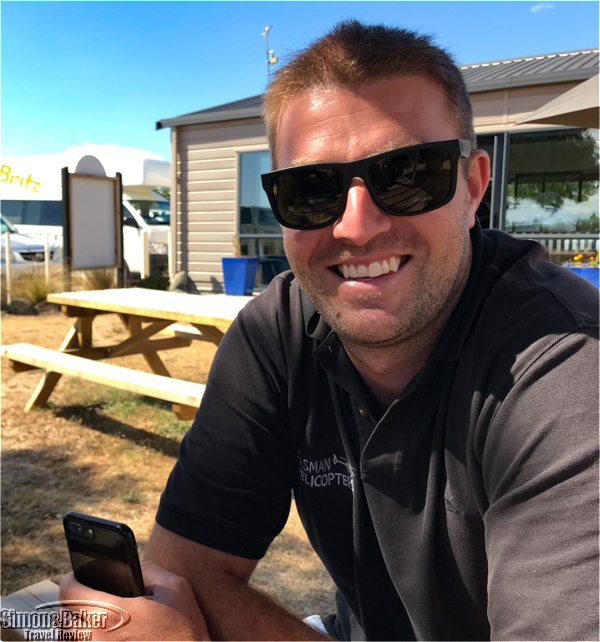
During a coffee break at Motueka Airport
Tasman Helicopters, co-owned by Ross Moore and Logan Moore, was established in 2015. According to Logan, who responded to questions by email, the company had no safety incidents.
Thanks to nice weather the scenery sparkled. The sky was clear and the flight was smooth, making time disappear faster than I anticipated. We landed at Motueka Airport, where my guide awaited me. As we continued on my tour memories of the flight lingered.
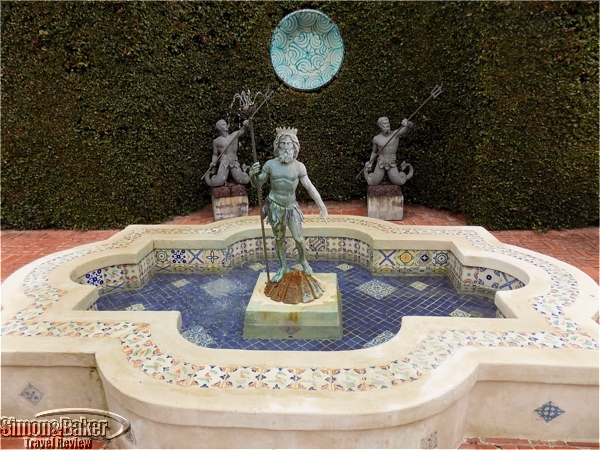
by Editor | Oct 7, 2019 | Attractions, Ecotourism
Article and photos by Scott S. Smith
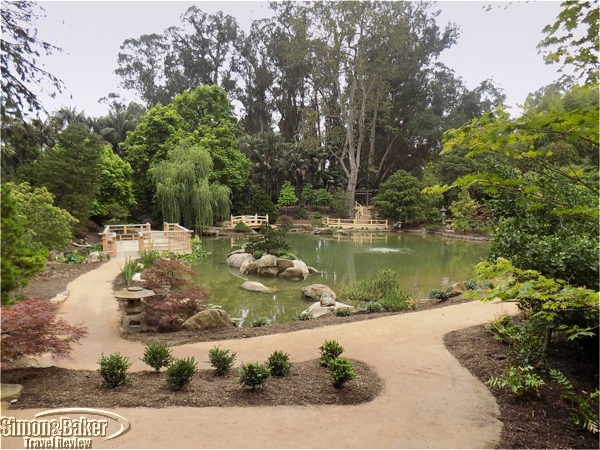
The 37-acres of Lotusland were divided into two dozen areas with a total of more than 30,000 plants.
Although my wife, Sandra Wells and I had no plans to visit Lotusland (695 Ashley Road, Santa Barbara, California 93108, +1 805 969-9990, www.lotusland.org) while we were in Santa Barbara, California we were glad we did. We had more than enough already crammed into the two days we expected to be in the area, located 90 miles north of Los Angeles and known as the Central Coast Wine Country. Perhaps because the city had been featured in the 2004 movie Sideways or because of its pleasant weather and lively arts scene many celebrities have homes there. Let’s just say we were very skeptical when we started and came away converts to the idea that gardens can be fascinating, educational, and fun.
Although the address is on Ashley Road the visitor entrance was at Cold Springs Road and Sycamore Canyon Road. Its long-in-the-making Japanese Garden had just opened two weeks prior to our visit and demand for tickets was backed up. I believe the heavy demand was due to the attraction’s location in a residential neighborhood that capped the number of visitors.
The 37-acres of Lotusland were divided into two dozen areas with a total of more than 30,000 plants, including 3,000 different types of plants, starting with the Australian Gardens at the entrance, which featured, among others, the tea trees from which the well-known healing oil is extracted. Just beyond the gate was the Japanese section (started in 1968, with a final budget of $6 million). It was being finished when we arrived, including the addition of a pagoda as well as the placement of koi and catfish in the pond.
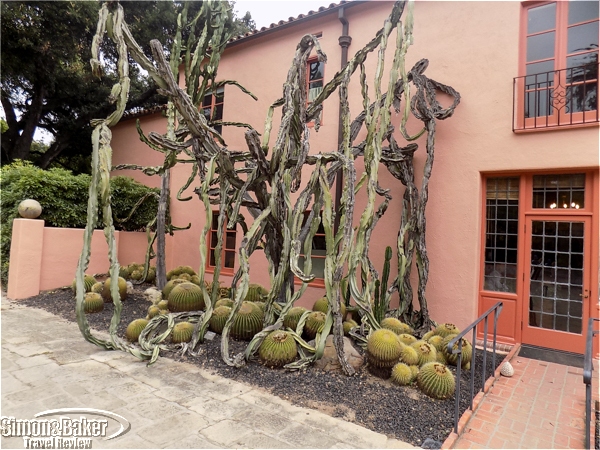
Part of Madame Ganna Walska’s home where the Lotusland offices are now located
Our guide was the well-informed Craig Morgan, whose passion for the beauty and benefits of plants in general and enthusiasm, especially for the garden, sparked our interest. When we later read The Healing Power of Gardens by Oliver Sacks, M.D., in his collected essays, Everything In Its Place, in which the famed observer of the human condition spoke about his experiences using gardens as healing centers we thought of Lotusland.
Then there is the colorful back story. Ralph Stevens bought the property in 1882 for his commercial nursery and home. His widow operated it as a guest ranch, and put it to other uses for 17 years. President Herbert Hoover visited for a garden fundraiser in 1937.
Future owner Ganna Walska was born Hanna Puacz in Brest-Liovsk, Poland, in 1887. At 25, she eloped with a Russian count and seven years later was studying singing in Paris and working under her new stage name. The following year the Russian Orthodox Church dissolved their marriage and Walska moved to New York City to escape World War I. While singing at a theater, she developed a throat ailment that took her to Joseph Fraenkel, M.D. They married 10 days later. In 1918, she made her concert debut on the same bill as legendary tenor Enrico Caruso. At her operatic debut in Havana, Cuba, at the end of the year she met Harold McCormick of International Harvester, a sponsor of the Chicago Opera.
After Fraenkel died, Walska was devastated. When she met rich heir Alexander Cochran on a voyage to Paris they married. Back in New York, she pursued her budding interest in mysticism and seances, as well as a friendship with McCormick, who arranged her debut with the Chicago Opera. A jealous Cochran forced her to cancel her performance. She divorced him in 1922 and married McCormick. He planned a 23-city United States concert tour, but she cancelled the first half when he underwent an appendectomy. He bought her a theater in Paris, which she managed for 10 years and ended up owning for nearly half a century. She made concert tours of America in 1923, 1925, and 1928, the only times during their marriage she visited the United States, despite McCormick’s residence in Chicago. He divorced her in 1931 on the grounds of desertion, but they remained friends. She lived half the year in France, half in New York, where she continued to explore Indian philosophy and her fascination with hypnotism. In 1940, she escaped France on the last commercial passenger ship before the Nazi occupation.
In New York, she studied yoga with Theos Bernard, known as the White Lama. After Walska’s next husband, a physician, died in 1940, Bernard proposed and they decided to buy what was then known as Cuesta Linda, renaming it Tibetanland, with a plan to turn it into a monastery for Tibetan monks. They began planting a variety of gardens and Walska published her autobiography, Always Room at the Top, in 1943. Three years later, they divorced and she never remarried, dedicating her life to collecting rare plants from around the world and creating a unique landscape. She renamed the garden Lotusland because the lotus, which grows in mud but produces a beautiful flower and could be a metaphor for human aspiration, is regarded by many cultures as a symbol of enlightenment and rebirth. She died in 1984. The Ganna Walska Lotusland Foundation spent the next nine years preparing the property for public tours.

There was art amidst the plants at Lotusland
Lotusland was full of sculptures, such as in the Theatre Garden, which featured a collection of grotesques, 17th century stone figures of an Italian entertainment troupe of dwarves. They were so valued that Walska had them buried with her jewelry when she fled the German occupation. Around some of the pools, like the one in the Aloe Garden (with its 140 species), were giant open clam shells, colorful abalone shells, and turquoise glass (retrieved from the slag at the factory making Sparkletts water bottles). Colored tiles, stones, and sand were used to create pictures and designs by the sides of the paths. There was a Topiary Garden featuring plants growing over wire frames that represented a menagerie, as well as an enormous working clock of flowers. According to Lotusland promotional materials Walska was one of the first garden designers to plant groups en masse to create a dramatic impression.
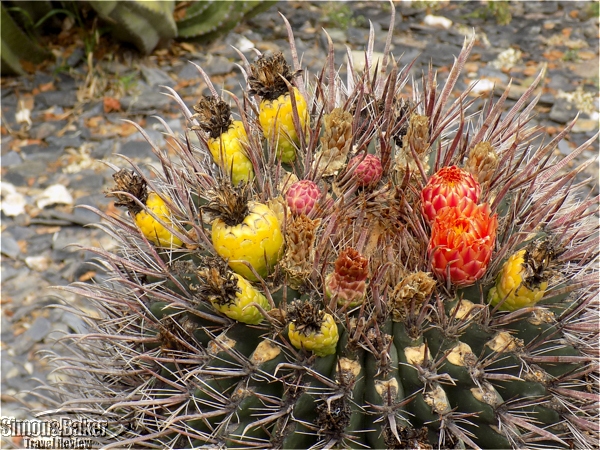
Cactus flowers provided unexpected color
The Cactus Garden contained more than 300 species (one-sixth of the total known), grouped by their country of origin (native to the Americas, they spread to the rest of the world). All have adapted to conserve water, such as thickened parts for storage and the spines, which are its leaves that curb water loss by reducing air flow close to the stem and providing some shade (as well as defense against critters). Unlike other plants, their photosynthesis process, in which carbon dioxide enters the plant and water escapes, cacti delay the latter until night, reducing water loss. A mature saguaro can absorb as much as 200 gallons of water in a single rainstorm. We were amazed at how cacti differed in their shapes, colors, flowers, and the way they twisted to adapt to their neighbors.
It was surprising to come across other species in the Tropical Garden, such as the epiphyllum native to the Brazilian rainforest. We had never thought of cactus being a tropical plant.
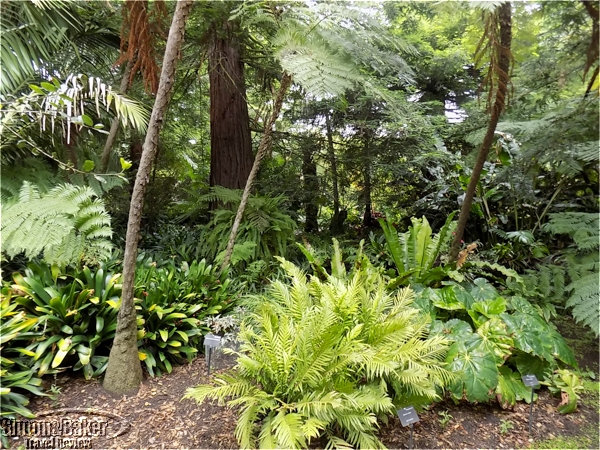
Broad-leafed begonias among the ferns and a mature Dragon Tree, with its umbrella-like branches.
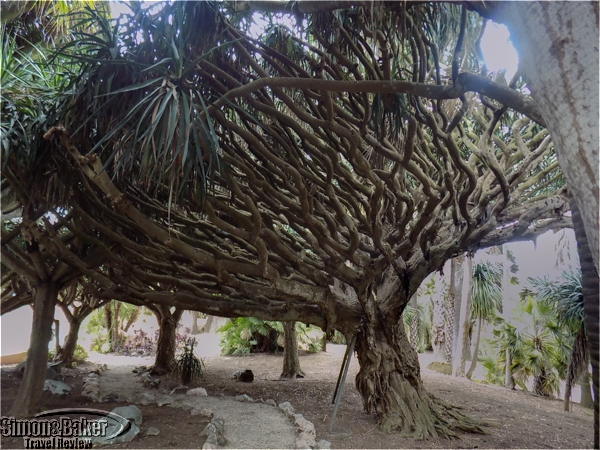
Although we thought of Lotusland as an oasis for desert flora and there were sections for dry-climate trees like palm and olive, it was also lush with a wide variety of plants of other climes.
We thought of Lotusland as an oasis for desert flora and there were sections for dry-climate trees like palm and olive, but it was also lush with a wide variety of plants of other climes. Lotuses and lilies covered a pond in the Water Garden and the Insectary Garden attracted butterflies and insects that have helped gardeners avoid using pesticides. Ferns shared shade with broad-leafed begonias (whose asymmetrical leaves are unique to the plant world in not matching), while other sections were devoted to cypress trees and roses. Mature dragon trees, whose branches reached almost vertically toward the sky, were striking and emitted a red resin known as dragon’s blood, used in folk medicine and favored by Roman gladiators to give them a fierce appearance. Lotusland had one of the most significant collections of bromeliads in the United States, a diverse family whose members trap moisture. They were clustered in several of the gardens, ranging from Spanish moss to pineapple.
One area in transition was the Blue Garden, which Walska had stocked with blue and silver-gray foliage. Tall trees had blocked the sun and the area was being replanted.
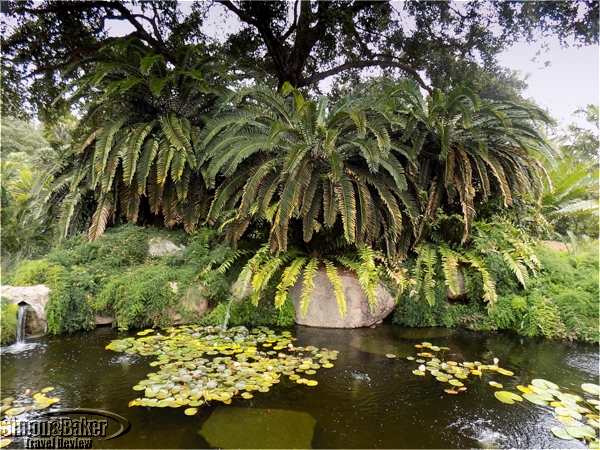
Three of the rarest plants on the planet, giant cycads
The most important section was devoted to the cycads, plants found in the fossil records going back 300 years, whose enormous cone-like reproductive structures called strobili (some weighing 30 pounds) were eaten by dinosaurs. Individual plants are either entirely male or female and may live as long as 1,000 years. They have stout, woody trunks that are often under the ground, while the foliage emerges from the top and grows in a rosette form, so they can look somewhat like ferns or palms. There were 900 specimens in the Cycad Garden.
In 1977, Walska auctioned her jewelry to pay $980,000 for two of the rarest plants in the world, two encyphalartos woodii cycads. Another was added later at an undisclosed price. Five were left in the world, all in private hands and all of one gender. It was believed that there were none left in the wild.
The horticultural wonderland of Lotusland impressed us. We were constantly surprised by the garden’s rare species, the exotic appearance of so many plants, and their beauty (not to mention the interesting story of Madame Walska). We now understand what she meant when she said in her autobiography that she was “the enemy of the average.” We look forward to exploring other gardens across the world.
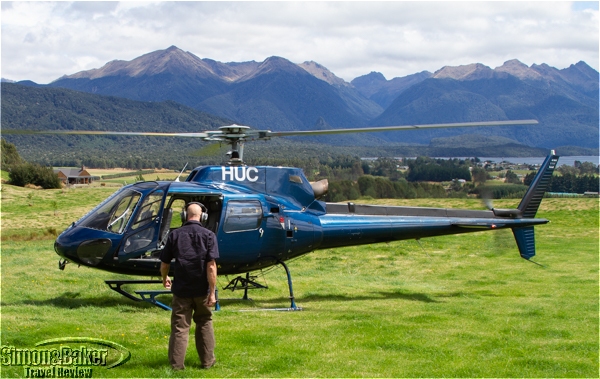
by Editor | Sep 16, 2019 | Attractions
Article and photos by Elena del Valle

We spent a few minutes at the hidden valley of Campbell’s Kingdom (click on photo to expand image)
One of the activities I most remember from a trip to New Zealand this year was a 60-minute Doubtful Sound Gold Star Flight. Although it was originally supposed to be the twice as long Dusky & Doubtful Sound flight poor weather caused it to be severely shortened. To say the flight was bumpy is an understatement. Because of the conditions in the sky everything was gray and wet. Despite that the scenery was magnificent in every direction. From my window side seat I saw oversize natural beauty with no sign of human habitation as far as my eyes could reach. It was one of the highlights of my Intrepid tour in the South Island.
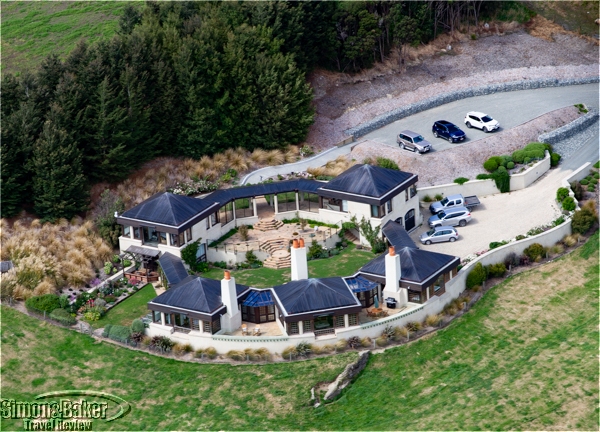
The helicopter picked us up at Cabot Lodge, where I was staying
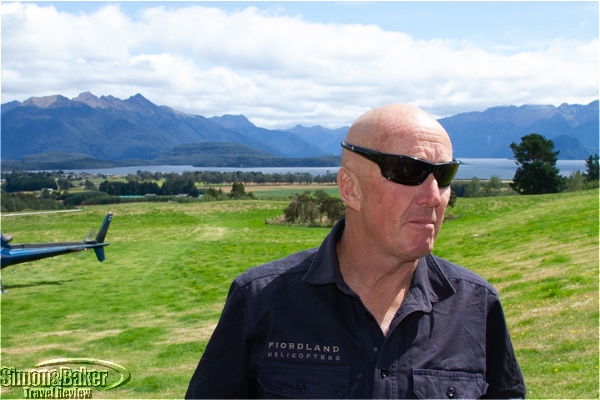
Our pilot Kim Hollows, founder of Fiordland Helicopters
With the arrival of the storm I had become convinced my only chance to see the famed Fiordland National Park would vanish. According to Fiorland.org, the park is over 1.2 million hectares large, and encompasses mountain, lake, fiord and rainforest environments. Due to the remote location and my tight itinerary it wouldn’t have been possible to reschedule the flight. When my guide described the weather the day prior to the flight I crossed my fingers that we might have a chance to see the park. After two or three delays I figured it wouldn’t happen so when the chopper landed on the green lawn of Cabot Lodge, where I was staying, I was elated.
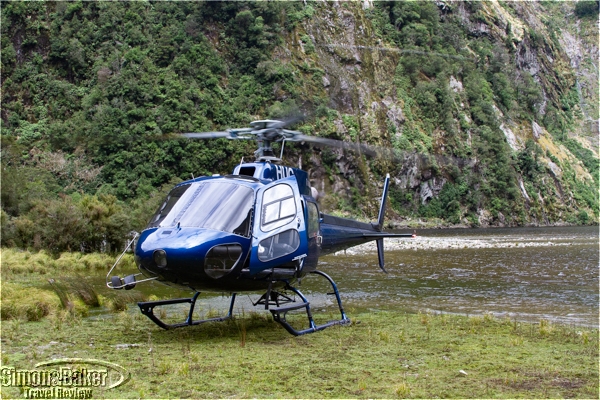
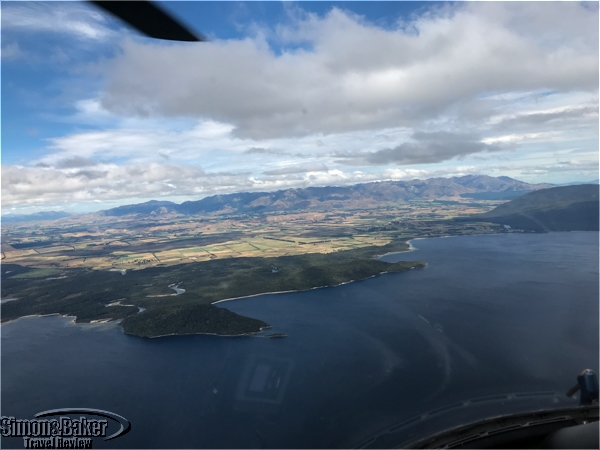
We flew in a late model AS350 B2 Squirrel.
Minutes after Veronika Vermeulen, my guide, and I rushed out to meet Kim Hollows, chief executive officer and founder of Fiordland Helicopters (K.E. Hollows Ltd, 6 Milford Crescent, Te Anau 9600, New Zealand, +64 (0)3 249 7575, www.fiordlandhelicopters.co.nz, info@fiordlandhelicopters.co.nz) we were airborne. Given the turbulence I appreciated that as we departed our pilot said little beyond an initial greeting and boarding instructions. His quiet and energetic demeanor inspired confidence. Kim’s attention was on flying that day. Mine was on the view and taking photos while praying that my stomach would keep it together until we returned.
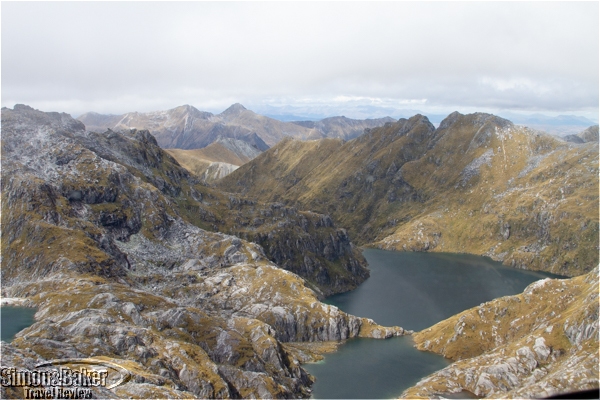
Fiordland National Park
The highlight of the flight were expansive views of Doubtful Sound, the second largest of the fourteen fiords in the park. Since Doubtful is not as popular as it’s sister fiord Milford Sound, the the flight was meant to make visitors feel “like you are alone in the middle of nowhere.” It did. I’m not sure when we crossed the main divide. I remember the tall unnamed waterfall in the hidden valley of Campbell’s Kingdom because it was the only place we landed. We flew in a late model AS350 B2 Squirrel. The company declined to disclose the hours flown or the year of manufacture “due to privacy.” The aircraft could accommodate up to six passengers with a maximum internal weight of 650 kilos.

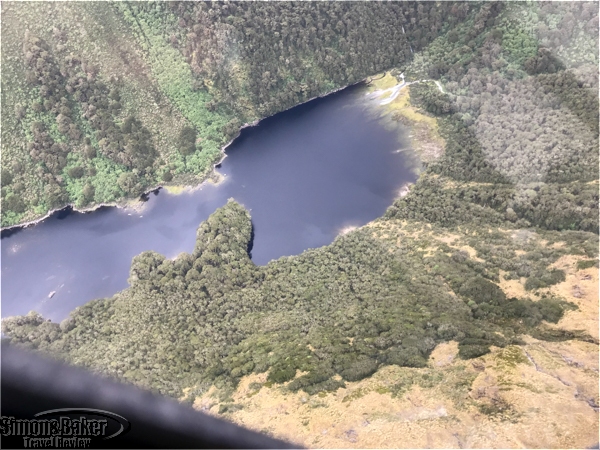
The scenery was awe inspiring.
Kim obtained his commercial pilot’s license in 1980. Although he has flown throughout New Zealand he has spent most of his air time in the lower South Island and Fiordland, according to a staff person at his office who later responded to questions via email. In addition to scenic helicopter flights he has been involved in deer recovery, commercial helicopter operations, filming, photography, and work for the Department of Conservation. He founded K.E. Hollows Ltd, now known as Fiordland Helicopters, in 1986. The spokesperson indicated the company’s safety record was impeccable. Relying on his vast knowledge and passion for the region he made Ata Whenua – Shadowlands, a film that shows daily at the Fiordland Cinema nearby. The owners of Cabot Lodge kindly made it available so the other lodge guests and I could watch it on my return from the flight. The clear weather conditions showcased in the film made me further appreciate the awe inspiring scenery. Should I return to New Zealand I would love to include the Dusky & Doubtful Sound flight in my itinerary. I will recommend it to friends traveling to the South Island.

by Editor | Aug 5, 2019 | Attractions, Ecotourism, Luxury Travel
Article and photos by Elena del Valle

Wayne Allanson aboard our 10-seat KeelowCraft on the 52 kilometer Waiatoto River in New Zealand
I didn’t know quite what to expect during the off the beaten track Waiatoto River Safari in the 355,000 hectare Aspiring National Park, part of the United Nations Educational, Scientific and Cultural Organization (U.N.E.S.C.O.) Te Wāhipounamu World Heritage Park in the South Island of New Zealand. My first clue was Ruth Allanson’s smile when we stopped to check in and sign release forms. It lit up her face and put me at ease. She and Wayne, her husband, owned the company.
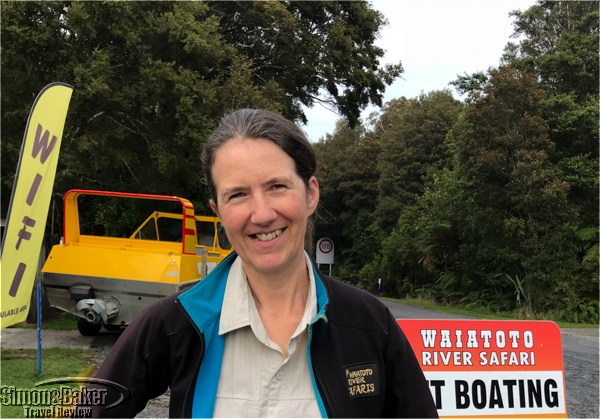
Ruth Allanson of Waiatoto River Safari

During the tour Wayne stopped in a sheltered corner of the river to tell us about the park.
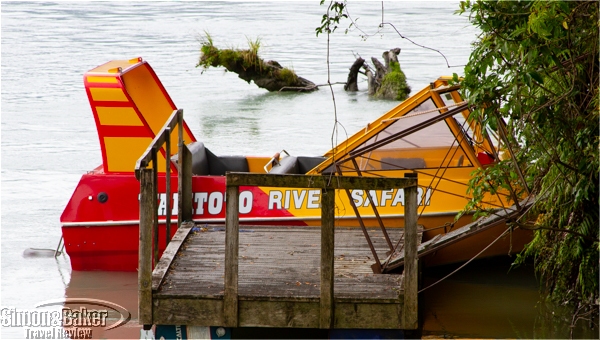
Our departure point
The simple indoor stand housed a desk, promotional brochures and a few local stonework souvenirs. From there a two minute drive led to our departure point, where moments later we met Wayne on the bank of the 52 kilometer Waiatoto River. We were 23 kilometers from Haast and about 200 kilometers from Queenstown.
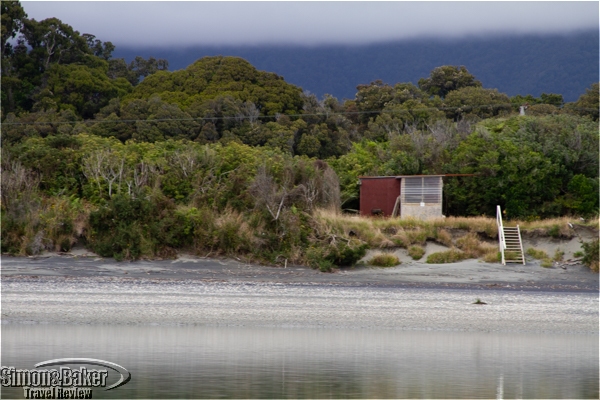
The Waiatoto River, 23 kilometers from Haast and about 200 kilometers from Queenstown
Although it was a clear summer day when we arrived (by the time we returned clouds had descended) there was a chill in the air that promised it would be cooler still on the boat. After applying liberal amounts of insect repellent against the sandflies and donning a loaner coat and I was ready. Veronika Vermeulen, owner of Aroha New Zealand Tours and my guide on an Intrepid tour of the South Island, and I followed Wayne onto a 10-seat KeelowCraft for our two and a half hour private tour. Our boat was 5.7 meters long, 2.2 meters wide, required 125 milliliters of water to operate, and could accommodate up 11 passengers plus driver. It had a Chev 350 V8 petrol engine with a Hamilton 212 jet pump.

The Waiatoto River, part of the U.N.E.S.C.O. Te Wāhipounamu World Heritage Park – click to enlarge
The setting was beautiful. The tour was one of the highlights of my trip to the South Island. The river and lush green vegetation were all around us. After the many crowded attractions we had passed on previous days it was wonderful to be alone on the river. This was in part because the tour was the only way to visit the unspoiled area by land and water. Later Ruth explained by email that the scenery and nature are unique to New Zealand.
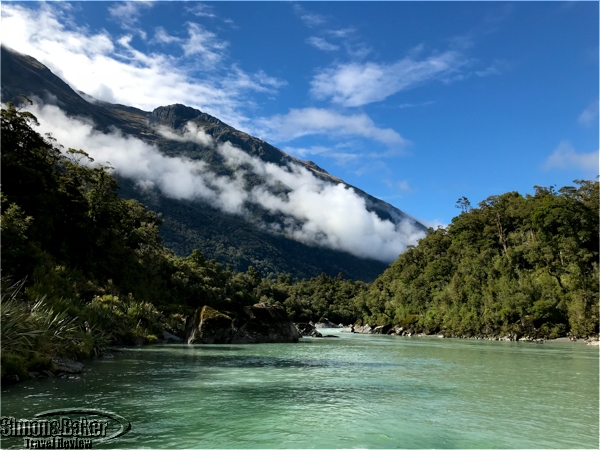
One of my favorite aspects of the tour was that we were the only people visible on the river.
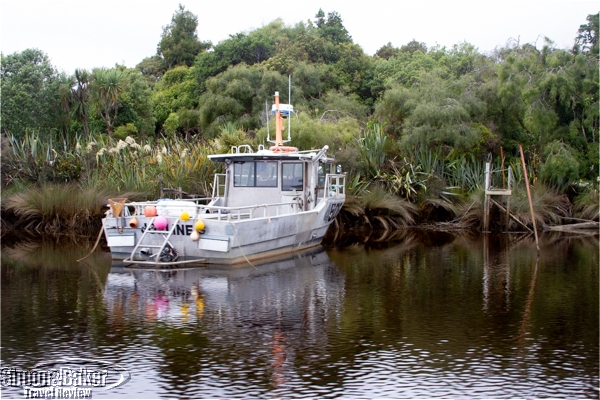
One of few boats we saw although during the whitebait season hundreds of locals descended on the river for their share of the popular fish
The loud engine sounds ensured we focused on the scenery rather than conversation. Wayne slowed down or stopped to show us points of interest, share information and indulge my photo needs. On one of the stops he offered us whitebait snacks. During the whitebait season, hundreds of locals descended on the river for their share of the tiny fish. Although it was past whitebait season Ruth and Wayne had a frozen supply from which they made the snacks.
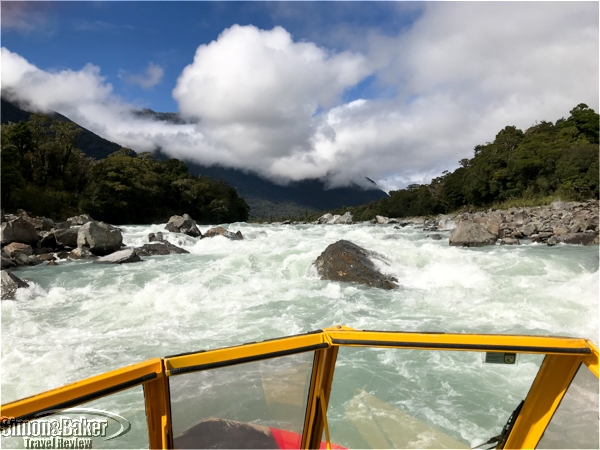
White water on the Waiatoto River
We covered 23 kilometers until the rapids became impossible to navigate. There Wayne tied the boat to the shore. It was easy to step onto land through the front of the boat. Veronika and I gazed at the rushing water, while Wayne secured the boat. Once he joined us we walked 500 meters into the quiet landscape before heading back down the river to the Hindley Stream. By the time we returned to our departure point we had covered 50 kilometers during the tour.
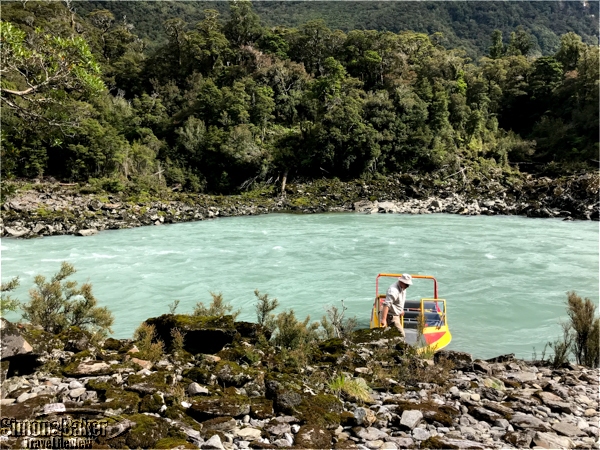
When the river became unmanageable we stopped for a short stroll.
It was nice to know the boats operated with Qualmark Environ motors specially imported for their low fuel use and clean running. I saw no pollution in the water or on land. The Allansons encouraged their clients to “take photos and leave footprints only.”
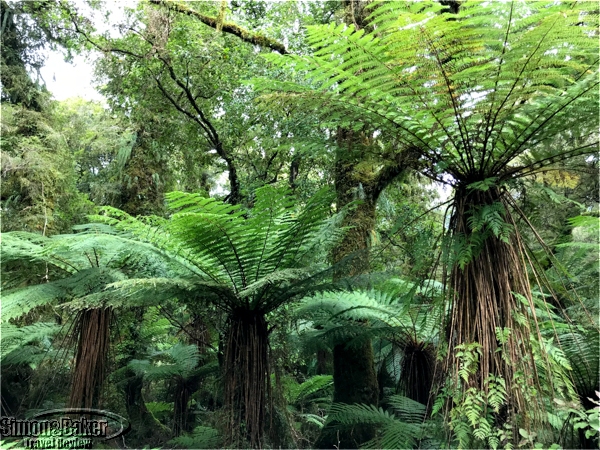
We encountered lush greenery on our short walk.
With advance notice they were able to accommodate some travelers with disabilities. Babies from about 5 months old (provided the life jacket fit) could join their tours and there was no upper age restriction. Life jackets were available up to XXXXL.

At our first stop – click to Enlarge
Once we glided over the river I was glad for the extra loaner layer and the safety of the life vest. Although at one point there were sandflies, perhaps because of the copious quantities of natural repellent I lathered on, they didn’t bother me at all. Waiatoto River Safaris Limited (975 Haast-Jackson Bay road, Hannahs Clearing, Haast, 7844, New Zealand, +64 3 7500 780, www.riversafaris.co.nz, info@riversafaris.co.nz) was owned and operated by a local family since 1997. Theirs was the only company with permission to offer boat tours on Waiatoto River (helicopter companies were allowed enter the park). Ruth and Wayne held Martime New Zealand commercial jet boat licenses, first aid and commercial pilot licenses as well as airplane instructor ratings. They had 12 years of jet boating experience.
According to the U.N.E.S.C.O. website, Te Wāhipounamu World Heritage Park covers 10 percent of the landmass of New Zealand. It has fjords, rocky coasts, towering cliffs, lakes and waterfalls. It was worthy of a detour. I especially enjoyed seeing it by boat.



























































